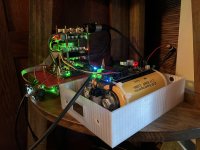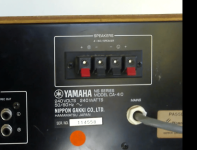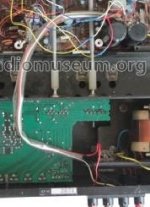I'm coming from a TPA Buffalo build that was fed by my main PC. It looks like I should build a Pi-less setup with Ian's modules. While I'm still reading about them, I need some help with the flow so to speak. My goal is to use an Amanero as the USB input, I would like to run this in synch mode, not sure what clock modules I need and cables? For power supplies I'd like to start out with the supercap options. I'm not sure what is the best power config for all these modules is? Can someone confirm the the stack below is what I need for input and output as well as the best clock and power modules?
#4B ES9038Q2M Dual Mono II
#7A Transformer I/V (Bisesik) or #6B OPA861 I/V
#1D FifoPiQ7
#49B MonitorPi Pro
#19C ReceiverPi DDC (has USB, I2S over HDMI, RPi, RCA and OPT inputs)
#4B ES9038Q2M Dual Mono II
#7A Transformer I/V (Bisesik) or #6B OPA861 I/V
#1D FifoPiQ7
#49B MonitorPi Pro
#19C ReceiverPi DDC (has USB, I2S over HDMI, RPi, RCA and OPT inputs)
Check this out. Ian posted it not too long ago. I’m am using OPA861 IV powered with linear pi dual. And have the ultra caps with UCPure III to power the fifoPiq7 two SCPure clocks and the DAC board. Need to case it up. To busy listening 👂
Attachments
Thanks, that makes more sense power wise. Since I would be PI-less, could I run everything off of one UCPure III? Or one for the digital side and one for the output stage?
You can adjust a delay on the FifoPiQ7 from the MonitorPi (Pro or not). So yes, you have to add a Monitor Pi. I would buy a Pro, it has more features. Maybe there is another way to change this, it's the only one I know and this is how I solved this.Still troubleshooting my streamer build:
With both moOde and GentooPlayer I get music, however the first few seconds of the track are missing after hitting Play. Any idea why that is?
- StationPi Pro
- FifoPi Q7
- HDMIPi Pro
- PurePi II
- UcConditioner II 3.3V
Can it be remedied by changing a FifoPi setting?
(I am reluctant to break things open to change its jumper settings; maybe I should add a MonitorPi...)
@iancanada I have FifoPi Q3, newer Q7, 9038 DAC hat and will be getting SCpure clocks and HDMI pro. I will set up a streamer that will feed a separate Andrea DAC with drixo clocks and I also want to continue using 9038 DAC hat with your OPA 861 output stage. If I keep the streamer as a separate unit - using FifoPi Q3, SDK clocks, HDMIpro - feeding 9038 DAC with FifoPi Q7 and SCpure and also Andre Dac will I lose sound quality or should I just keep the 9038 DAC stack combined with HDMI pro as output device and use the Q7 plus SCpure on the “Ian” stack?
Thanks, much appreciated! I will order a MonitorPi Pro.You can adjust a delay on the FifoPiQ7 from the MonitorPi (Pro or not). So yes, you have to add a Monitor Pi. I would buy a Pro, it has more features. Maybe there is another way to change this, it's the only one I know and this is how I solved this.
Only one holding me back as I wonder whether I should also order a ReceiverPi DDC to get DSD256 to work. I found what I read so far a bit confusing. For me the essence of a streamer is that one streams audio to it via ethernet (or WiFi) and then it outputs in the preferred format (in my case I2S) to the DAC.
Although it is advertised that the HDMIPro can go up to DSD1024 native, I have read that this setup
ethernet > RPi4 > FifoPi Q7 > HDMIPro > I2S > DAC
can not even do DSD256. Is that correct?
Does the HDMIPro require USB input in order to play DSD256? But in that case it would no longer be a streamer setup. And where would the ReceiverPi DDC fir into the chain to make this possible? I see that it can do Digital To Digital conversion with a choice from multiple inputs but these do not include RJ45.
Maybe I am just thick, and missing something...
Hi folks,
I have a question with outputs of UCCPURE MKIII for powering clocks.
What is the max gauge possible with J9 Switched output? 14awg?
With J10, J13 Continuous output, is ist ok to replace Molex Terminal: 39000038 with Molex terminal 39000090 in order to use 16AWG instead of 18AWG?
thank you
Terry
I have a question with outputs of UCCPURE MKIII for powering clocks.
What is the max gauge possible with J9 Switched output? 14awg?
With J10, J13 Continuous output, is ist ok to replace Molex Terminal: 39000038 with Molex terminal 39000090 in order to use 16AWG instead of 18AWG?
thank you
Terry
yes, the thicker the wire, the lower the resistance.With J10, J13 Continuous output, is ist ok to replace Molex Terminal: 39000038 with Molex terminal 39000090 in order to use 16AWG instead of 18AWG?
but I think that the connector on the FiFoPi cannot accept a thicker wire than 1.5 mm2
I believe I figured it out. This should be able to play DSD256 and upwards:Thanks, much appreciated! I will order a MonitorPi Pro.
Only one holding me back as I wonder whether I should also order a ReceiverPi DDC to get DSD256 to work. I found what I read so far a bit confusing. For me the essence of a streamer is that one streams audio to it via ethernet (or WiFi) and then it outputs in the preferred format (in my case I2S) to the DAC.
Although it is advertised that the HDMIPro can go up to DSD1024 native, I have read that this setup
can not even do DSD256. Is that correct?ethernet > RPi4 > FifoPi Q7 > HDMIPro > I2S > DAC
Does the HDMIPro require USB input in order to play DSD256? But in that case it would no longer be a streamer setup. And where would the ReceiverPi DDC fir into the chain to make this possible? I see that it can do Digital To Digital conversion with a choice from multiple inputs but these do not include RJ45.
Maybe I am just thick, and missing something...
Correct? In any case, I have included an Amanero board (plus a ShieldPi as overkill) board in my order 🙂ethernet via RJ45 > RPI4 > USB cable > Amanero on StationPi > FifoPi Q7 > HDMIPro > I2S > DAC
Hello,yes, the thicker the wire, the lower the resistance.
but I think that the connector on the FiFoPi cannot accept a thicker wire than 1.5 mm2
If you dissect a typical molex connector you will soon realize that the weakest link is the connector itself. I meant the connector is ok but the difference between 1 or 1,5 mm2 cable will be nullified by the connector.
4 decades ago i started with the notorious Monster cables in combination with my Yamaha integrated amp. This device had one of these typical connectors in the days back then which on the interior where '' continued ' by very basic wires. Of course at my loudspeakers side situation was pretty similar.
Back then replacing the Yamaha terminal by professional terminal brand like Elma and upgrading the cable from circuit board to inside terminal gave more improvement than replacing my loudspeaker cable (a tad better than lamp post chord) by Monster.
If i show pictures to co workers who work on electric train power supplies they cant stop laughing!
Greetings, Eduard
Attachments
Hi folks,
I have a question with outputs of UCCPURE MKIII for powering clocks.
What is the max gauge possible with J9 Switched output? 14awg?
With J10, J13 Continuous output, is ist ok to replace Molex Terminal: 39000038 with Molex terminal 39000090 in order to use 16AWG instead of 18AWG?
thank you
Terry
Good thought process on maxxing out the thickness of the cabling for the clocks. I only have UcPure MKI and MKII, but this should still apply.
I don't think there is a max guage on the J9 output as you can solder the thickest guage possible to the terminal if needed. But you do have to worry about the other end. For example, I use Keystone terminals which has a "Wire Guage Max" of 14AWG for the "Clean Side" of the Q7 and for the StationPi.
https://www.mouser.com/ProductDetail/Keystone-Electronics/8718?qs=%2BS1bAMbChF8qBANams/R5Q==
Because the Molex Contacts max out at 16AWG and my supplier does not carry 14AWG PTFE Solid Core, I decided to settle @16AWG PTFE Solid Core.
When I received the 16AWG wiring, I realised that the Molex Connectors I ordered a few years ago max out at 18AWG. But because I'm using solid core and the wire is super tight and compact, I was able to use the Molex Connectors that max out at 18AWG.
The Molex Connectors that max out at 16AWG is in my Mouser Project for my next Summer Project. So I was lucky this time around. But of course, the Molex Connector @16AWG you have in mind plus 16AWG is a great idea. But you have to account for the other end too as I don't know if the generic terminal can fit 16AWG as I use exclusively Keystone terminals.
https://www.diyaudio.com/community/...epo4-battery-power-supply.327105/post-7494588
Solid Core wiring is great as it's as close to bare metal performance as you can get. It's impenetrable to RFI/EMI as it's solid. The PTFE Teflon sleeving also provides excellent shielding against RFI/EMI. One can oven bake PTFE solid core for a short time if needed for the analog side as that improves SQ properties when it cools down over a 24 hour period.
EDIT:
I use 16AWG Cooper to RPi-side and Audio-side of StationPi.
I use 18AWG Silver to anything clock-related. My Supplier doesn't carry 16AWG Silver, but it's okay as it's extremely expensive and my Project is in a Production Freeze.
But concerning Molex Connectors, I was still lucky to fit 16AWG Cooper to Molex Connectors that were Max 18AWG. I had 8 in inventory, but sacrificed 6 Molex Connectors until I finally got it to fit snug. I look forward to ordering the Molex Connectors that Max 16AWG one day.
Last edited:
Hello,
Garden hose wire will transfer all the vibrations into the '' clock area '' much better. The bigger the diameter of the cable the less contact area you will create in the contact area of the Molex.
If i consult all the construction manuals that my co workers need at the '' electrical division '' things are getting serious. They are not there to serve as a kind of guidance. NO, if an accident happens and insurance company staff can prove that things were not done as prescribed in the manuals they wont pay.
BUT of course audiophiles can use the same 5 $ crimping tool for the complete collection of AMP terminals from Alibaba.
Greetings, eduard
Garden hose wire will transfer all the vibrations into the '' clock area '' much better. The bigger the diameter of the cable the less contact area you will create in the contact area of the Molex.
If i consult all the construction manuals that my co workers need at the '' electrical division '' things are getting serious. They are not there to serve as a kind of guidance. NO, if an accident happens and insurance company staff can prove that things were not done as prescribed in the manuals they wont pay.
BUT of course audiophiles can use the same 5 $ crimping tool for the complete collection of AMP terminals from Alibaba.
Greetings, eduard
Good Job on the overkill and being patient implementing the SC-PURE. Down the road, I may consider a ShieldPi too.I believe I figured it out. This should be able to play DSD256 and upwards:
Correct? In any case, I have included an Amanero board (plus a ShieldPi as overkill) board in my order 🙂
I think I'll go your way.I use 16AWG Cooper to RPi-side and Audio-side of StationPi.
I use 18AWG Silver to anything clock-related. My Supplier doesn't carry 16AWG Silver, but it's okay as it's extremely expensive and my Project is in a Production Freeze.
But concerning Molex Connectors, I was still lucky to fit 16AWG Cooper to Molex Connectors that were Max 18AWG. I had 8 in inventory, but sacrificed 6 Molex Connectors until I finally got it to fit snug. I look forward to ordering the Molex Connectors that Max 16AWG one day.
16AWG silver is 149,00 € per meter... So I will stick to 18AWG for clocks if I find it.
thank you for the 14awg Keystone terminal reference.
Thank you all for your answers
yes it seems logic. but I didn't think about that.Hello,
Garden hose wire will transfer all the vibrations into the '' clock area '' much better. The bigger the diameter of the cable the less contact area you will create in the contact area of the Molex.
So bigger gauge mono core for ESR or lower gauge multi-strands for better contact and less vibrations?
I think you are right 🙂) I buy good terminals but my crimping tool is a cheap one from aliexpress...BUT of course audiophiles can use the same 5 $ crimping tool for the complete collection of AMP terminals from Alibaba.
Greetings, eduard
Hello,
I think a good quality wire soldered directly at the board will outperform a connector which is in the end also soldered with a crappy piece of metal inside. I think most connectors being used by most hobbyist are not even original Molex ones Similar to the ultracaps from some Chinese knock off shop.
Our company gets all the our tools from a certified supplier. IF i would bring my own crimping tool from my shed because it allows me to work more quickly i would be in really serious problem if it gets reported.
Of course we are not that serious it is just digital sound reproduction.
Greetings, Eduard
I think a good quality wire soldered directly at the board will outperform a connector which is in the end also soldered with a crappy piece of metal inside. I think most connectors being used by most hobbyist are not even original Molex ones Similar to the ultracaps from some Chinese knock off shop.
Our company gets all the our tools from a certified supplier. IF i would bring my own crimping tool from my shed because it allows me to work more quickly i would be in really serious problem if it gets reported.
Of course we are not that serious it is just digital sound reproduction.
Greetings, Eduard
I think I'll go your way.
16AWG silver is 149,00 € per meter... So I will stick to 18AWG for clocks if I find it.
thank you for the 14awg Keystone terminal reference.
Thank you all for your answers
I'll post if I stumble upon any European Shops with Neotech.
I know Mundorf is popular in Europe, but I can't confirm if it's similar Solid Core that I use. Mundorf mentions "Solid" or "single-core" or "isolated, but since I don't have first hand experience with Mundorf wiring I cannot comment.
The pricing is similar.
But it's something I'm interested in for a future analog project as I exclusively use only Mundorf Silver / Gold Premium solder for everything and I love everything Solid Core.
https://www.hificollective.co.uk/wire/mundorf-silvergold-wire-110sgw.html
It's PTFE and has a voltage rating, but I cannot find any photos to confirm it's similar to the solid core as the Neotech.
Available in .5mm, 1mm and 1.5mm. I think it should be good for clock-related as an alternative to Neotech.
I guess Mundorf has a possible Solid Core Cooper option. Can't comment as I just stumbled upon.
https://www.hificollective.co.uk/wire/mundorf-mconnect-copper-soild-core-angelique-wire.html
Recommend PTFE as they have a cheaper bare metal option.
Last edited:
Hello,
I think a good quality wire soldered directly at the board will outperform a connector which is in the end also soldered with a crappy piece of metal inside. I think most connectors being used by most hobbyist are not even original Molex ones Similar to the ultracaps from some Chinese knock off shop.
Our company gets all the our tools from a certified supplier. IF i would bring my own crimping tool from my shed because it allows me to work more quickly i would be in really serious problem if it gets reported.
Of course we are not that serious it is just digital sound reproduction.
Greetings, Eduard
Even though it's securely screw torque-tightened on the terminals, do you think it's a good idea to also solder in the terminals on both the UcPure and UcBalancer?
After I recieve my Battery Boxes, I'm ready to Production Freeze my UcPures and can solder the terminals if optimal. I plan to add a Power Button to the case:
That's why I run my own genuine highly heat resistant nylon standoffs, M12 Nuts, terminals, clock cables, etc. I don't take any chance something can be a knockoff or not of premium quality. All this work, I rather run geniune Hirose clock cables not to mention they are much more user-friendly to hand snap-in.
Last edited:
- Home
- Source & Line
- Digital Line Level
- Asynchronous I2S FIFO project, an ultimate weapon to fight the jitter



